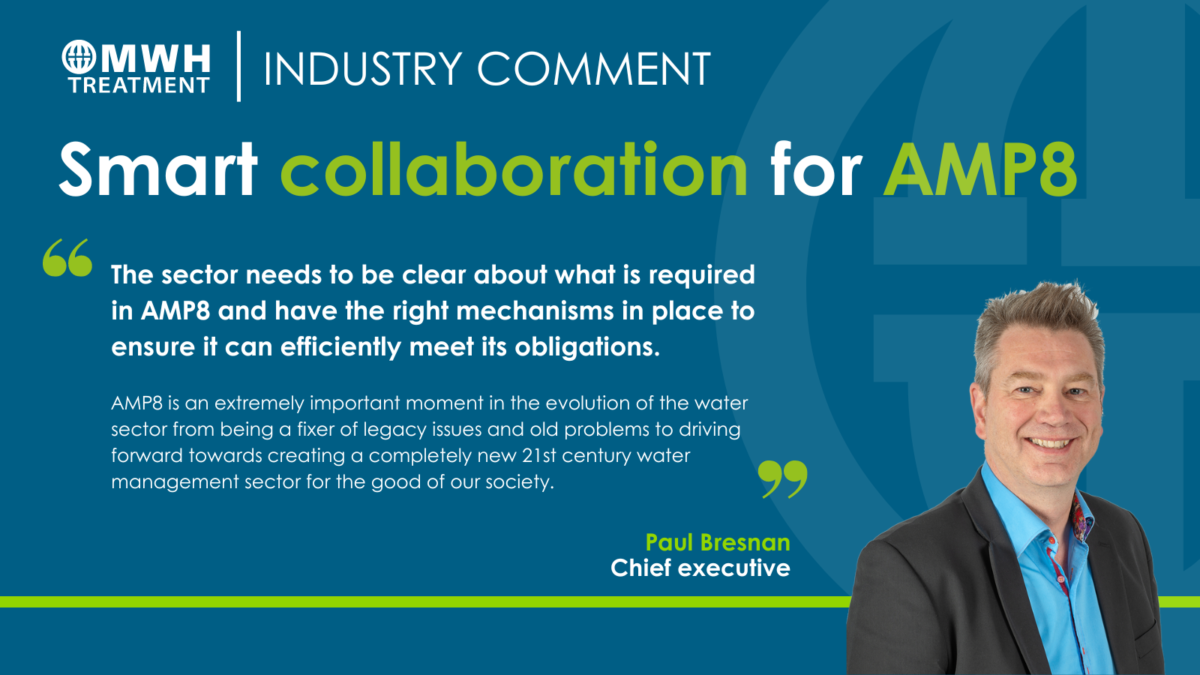Smart collaboration for AMP8

MWH Treatment Chief Executive Officer Paul Bresnan’s opinion piece first appeared in the March 2024 edition of The Water Report.
The water sector’s Asset Management Period 8 (AMP8) will see water companies in England and Wales committing to a spend that could be at least twice that of the current period at £96 billion. MWH Treatment Chief Executive Officer Paul Bresnan argues that, while the investment is essential, the sector needs to be clear about what is required and have the right mechanisms in place to ensure it can efficiently meet its obligations.
AMP8 is an extremely important moment in the evolution of the water sector from being a fixer of legacy issues and old problems to driving forward towards creating a completely new 21st century water management sector for the good of our society.
The challenges for the UK water sector are well documented, from the need to reduce leakage, water scarcity and pollution incidents to providing more resilience against extreme weather events. The net zero agenda will push the industry to further reduce process emissions, adopt new ways of managing biosolids and implement more nature-based solutions.
Furthermore, the water sector will need to look at increasing biodiversity net gain and achieving nutrient neutrality in catchments under severe strain. These challenges must be faced in an era of greater media coverage, increased political oversight and scrutiny and more demanding customers. This will require the industry to change to be more circular, inclusive and transparent.
Regulatory Clarity
The starting point for this discussion must be the need for clarity from Ofwat through the AMP8 determination. This is crucial because the determination represents Ofwat’s assessment of the water companies’ plans for 2025–2030 and details any challenges it has made to these plans. This insight is invaluable to the sector, but the true value lies in ensuring that the message is clearly articulated.
I accept that Ofwat has a very difficult task to achieve in trying to square the increased investment requests from the companies in the current climate of a cost-of-living crisis and recent damage to public trust in the water utilities.
From my previous AMP cycle experience, I know that the quality of the AMP determination has an immediate effect on programme affordability, visibility and stability. In previous AMPs, along with consulting with their customers, water companies have submitted plans based on an interpretation of their statutory duties. Ofwat has subsequently reviewed and rejected some of these for various reasons, with some resulting in a referral to the Competition and Markets Authority.
The resulting delays in agreeing the determination, in my experience, directly impact on the water companies’ ability to commit to a ‘no regrets’ allocation (for example, the remaining water industry national environment programme). The delays also lead to stranded mobilisation costs and, of course, affect our ability to commit to the critical resources necessary for delivery.
Affordability is always a key factor. I expect the upcoming determination to be no different, so the need for efficiency has never been greater. We need to think differently about what and how we deliver and enter AMP8 with a unified sector mindset that we need to provide more for less.
Capability and capacity
With most clients developing and delivering programmes that are significantly larger than the previous cycles, there will be immediate pressure on their capability and capacity. This potentially includes increasingly complicated programme and project development and allocation processes across the sector.
I know we can collaborate smarter to ensure successful delivery simplifying matters such as those development and governance processes, maximise templated solutions and embrace the efficiencies of off-site construction. With the exception of new technologies and innovations, there isn’t much we haven’t designed and built previously. For AMP8, we need to take those off-the-shelf solutions, minimise change and focus on improved productivity.
There are also many examples of what we can learn from other sectors too in how we can approach our work. It’s still a fair challenge as to whether we have truly penetrated the clay layer of preferential traditional engineering. For example, the housing sector, where see buildings going up in the half the time. There must be something more we can take from other sectors from a productivity perspective.
We do have great examples of projects with significant advances in safety, cost and time brought about by templating design, maximising off site work, pre-cast and factory-based manufacture followed by on-site assembly and this, in my view, needs to become the sector norm.
Supply chain appeal
This brings me to another crucial question that clients and water companies raised at the AMP8 engagement sessions I attended. This was: Given the size of the AMP8 programme and the competing national infrastructure programme, how can we make ourselves more attractive to the supply chain?
I have seen an effective response to this challenge that has included a move towards more industry-competing fees with a more appropriate risk allocation. I would say this is entirely the right approach and believe that the reality for AMP8 is that we could see programmes outstripping market capacity. Contractors that operate across several market sectors will have a choice on where they deploy their resources. In addition to this, if we are all chasing the same resources, we will simply inflate the internal market. This is where smart collaboration of our collective resources will provide a sector-wide efficiency.
We need to simplify the supply chain engagement processes. This, along with a more meaningful programme-level commitment and an ability to secure returns that compare to the best in the construction sector, will make the sector the preferred choice for these contractors across national infrastructure projects.
The good news is that the water sector is an industry that has a history of collaboration through organisations such as Anglian Water’s @one Alliance and British Water. It is encouraging to see several water companies adopt alliance- or enterprise-type models in which partners’ returns are dependent on each other’s performance. This will drive greater alignment and collaboration in critical areas such as resources and supply chain engagement.
The immediate priorities are programme visibility and stability. We need to quickly create ‘no regrets’ early start programmes, with simplified solution development and allocation processes. This will enable us to mobilise and focus our internal resources and commit meaningfully to our critical supply chain partners.
Innovation
In parallel, it is important for us all to challenge ourselves to deliver differently and have the collective bravery to trial new approaches. Innovation is crucial to support our ambition for the growth and development of the water sector.
In the medium to long term, we need to constantly improve the way we operate and use our resources from greater monitoring and analysis of our ongoing performance data and by forcing cross-pollination of best practice across all our frameworks.
The collection and use of enhanced data to monitor ongoing performance will give us greater insight into outperformance opportunities. Linking this data to developing technologies such as project management-focused artificial intelligence (AI) and machine learning (ML) really excites me. The potential is considerable. We are already seeing the benefits that tools such as AI and ML are bringing to various aspects of asset management and capital delivery, and I don’t think I am alone in realising that this is only scratching the surface in how they can support our efforts. I am certain that these resources will become a key enabler for our team as we seek to deliver the challenges of AMP8 and beyond.


